Egypt
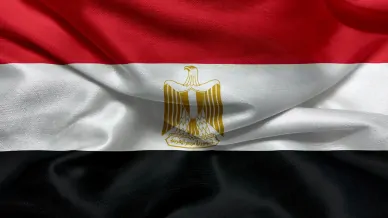
Egypt is a must-see country for everyone planning their first overseas journey. Low-cost travel offers to the Red Sea coast have always been the top ones.
However, even the savvy travellers who arrive in this incredible country always find something new and unknown. That is Egypt, the cradle of one of the oldest civilizations in the world.

General Information
The homeland of papyrus, inks, wigs, and wedding rings is one of the oldest in the world. It was 50,000 years ago when the full-grown states appeared within its territory.
At first, there were 20 of them, but the war between Upper and Lower Egypt (4th-3rd millennia BC) set things right. The cities united into one state under the reign of Pharaoh Narmer. He managed to establish a powerful government that controlled the enormous territory of the newly formed state.
Then the two-millennia rule of 30 pharaoh dynasties began. Those were hard times of Ancient Egypt as a state. Nonetheless, the challenging conditions did not deter science, medicine, culture, and agriculture from development.
The so-called gold mine on the Nile banks took fancy of Alexander the Great. That was how a new state called the Ptolemaic Kingdom emerged. Ptolemy I Soter became the first ruler, and the polis of Alexandria founded in the Nile Delta became the capital.
The Ptolemies grew into the mighty dynasty, and legendary Cleopatra was destined to become their last representative.
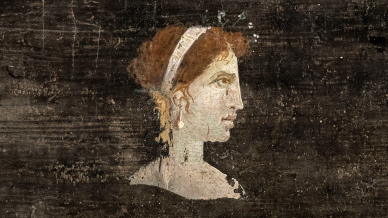
Posthumous portrait of Cleopatra VII of Egypt, from Herculaneum, Italy, c. 1st century
The Ptolemaic era left humanity with a rich legacy. There appeared the Library of Alexandria, several philosophical schools, and one of the seven wonders of the world — the Lighthouse (Pharos) of Alexandria.
Euclid, Archimedes, Eratosthenes, Strabo, and Claudius Ptolemy were living and working on their fundamental studies during that time. They are the ones who created mathematics, physics, astronomy, and other sciences.
In 30 BC, Cleopatra died, and the Ptolemaic times ended. Egypt became a province of the other ancient superpower — the Roman Empire. For 400 years of Roman rule, the emperors managed to convert the province to Christianity, revitalise agriculture and the economy first, but then brought everything to decline.
Long-suffering Egypt jumped from one ruler to another: after the fall of the Roman Empire, it belonged to Byzantium, the Arab Califate, and a range of the Turk dynasties. During that stage, the Islamisation and Arabisation of the country took place.
At the beginning of the 16th century, Egypt became a part of the mighty Ottoman Empire. However, that did not deter other countries from intruding on its territories. Napoleon Bonaparte and later the British Army used to launch their military campaigns.
At the beginning of the 19th century, the Ottoman Empire began to decline. Therefore, a wave of internal conflicts and rebellions took place in Egypt and its subject territories. In the 1880s, Anglo-Egyptian War broke out and ended with the British occupation of the country that lasted till Egypt declared independence in 1922. Fuad I became the King.
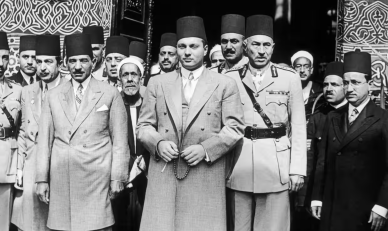
King Ahmed Fuad I of Egypt, circa 1922
In 1947, Palestine War began, and Egypt captured Gaza Strip. The 1950s were the stormiest times in the entire century. The years were full of military coups, internal conflicts, and the change of state system. Egypt turned into a republic when King Farouk I abdicated the throne, and the regent of infant monarch Fuad II stepped down from power in 1953.
Mohamed Naguib became the first President of the republic.
After some time, he was succeeded by Gamal Abdel Nasser, who attempted to unite Egypt and Syria into the United Arab Republic.
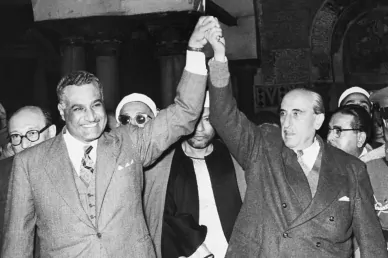
Gamal Abdel Nasser after signing a unity pact with Syrian President Shukri al-Quwatli that created the United Arab Republic
A new country existed from 1958 to 1961: Syria seceded. The United Arab Republic ceased to exist in 1971, and the Arab Republic of Egypt became its legal successor.
During the 1960s and the 1970s, the country followed the socialist path of development. That choice was made due to the influence and economic support of the USSR. The Aswan Dam was built at that time, and the entire process took ten years. Moreover, its spillway is considered the world’s highest hydro-technical construction (110 m).
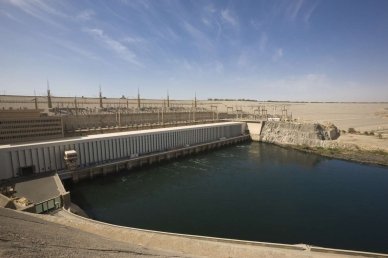
The Aswan Dam, Egypt
Thankful Egyptians even erected the monument to honour the Soviet engineers. It was 75 m high, a bit smaller than the USSR’s gift to the people of Egypt.
In the 1980s, there was the rethinking of the travelled path, which entailed the re-orientation of the development model. After that, Egypt fell under the US influence and has remained there up to date.
After the assassination of Anwar Sadat during the military parade of 1981, Hosni Mubarak became the next President and retained power till 2011. In a year, the next presidential election took place, and Mohamed Morsi won the presidency. However, he was in office not for a long period because in 2013 the military forces drove him from power. The current President of Egypt is Abdel Fattah el-Sisi.
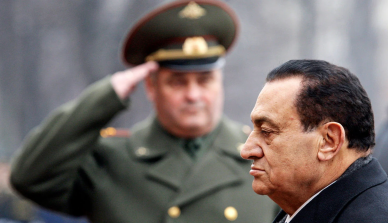
Hosni Mubarak
Geography and Climate
Egypt is the Middle East and North African country, having four terrestrial (Libya, Sudan, Israel, and Palestine) and two marine borders (Saudi Arabia and Jordan).
The country borders the Red and Mediterranean Seas connected by the Suez, the world's largest existing canal.
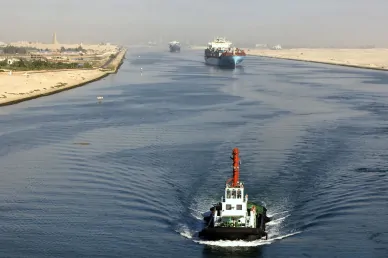
Suez canal
The Red Sea is the warmest in the world. Thousands of kilometres of luxurious beaches stretch along its coast, making Egypt world-famous for the best beach resorts.
Climate is very hot and dry. Summer months are usually the hottest: temperature during the day may reach +50°C, but in the evening, it drops to +22°C or +23°C.
Spending a vacation in Egypt in summer is not the best idea. The heat is scorching, and the deserts constantly cause natural disasters.
Sandstorms are a dreadful ordeal for local people and tourists to go through. The desert wind called khamsin brings the whirls of the heated sand. Egyptians are accustomed to the climatic extremes and thus can survive this hell. So for tourists, it is much better to put taking a trip on hold till late autumn or winter.
The Egyptian winter begins in December and ends in February as well as on the European continent. A typical winter day is about the air temperature of +25°C and the temperature of the sea of +23°C. Evenings and nights are really cold — +10°C - +12°C, so it is better to wear warmer clothes for walks and night-outs.
Population and Language
Egypt is a country where only 5% of its area is populated. This territory is inhabited by around 100 million people. The remaining part is not suitable for life as it constitutes the Sahara and Lybian deserts.
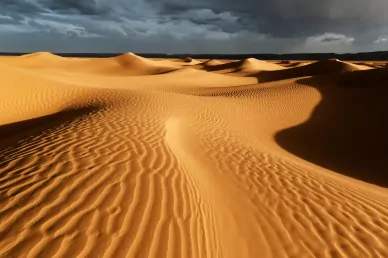
Sahara desert
The life of Egypt is concentrated in the delta of the Nile, the world’s longest and one of the most powerful rivers. It has always been this way: the Nile waters and valleys with fertile lands have been providing Egyptians with food, home, and even light.
The capital of the Arab Republic of Egypt is Cairo. The city is so overpopulated (more than 10 million people) that in 2015 the government announced the building of a new capital that could relieve the crowdedness of Cairo.
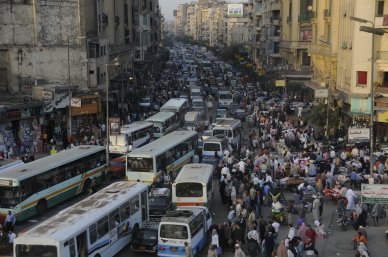
A crowd of people and cars on the streets of Cairo
Apart from it, there are other big cities like Alexandria (5 million people), Giza (3.5 million people), Shubra El Kheima (1 million people).
The official language is Arab. More than 90% of Egyptians profess Sunni Islam, and the other 10% belong to Christianity and other religions.
The Egyptian pound is the official currency.
Directions
Getting to Egypt as to any other Middle East country is primarily possible by plane.
There are some options to travel by bus from East European countries, but it is time-consuming and expensive. First, it will be necessary to arrive in any Balkan country, and then — to Turkey, Israel, and only after that — to Egypt.
Such a trip will take at least a week and will cost a lot of money. It is unlikely that somebody will consider this option of travelling unless the air carriers cease to provide flights to Egypt.
Many international airlines provide air connection with the country from international airports across the world:
- EgyptAir,
- British Airways,
- AirCanada,
- Air Arabia,
- Etihad.
To enter Egypt, tourists will need a visa. They may obtain it either directly at the airport or online. The first option is suitable for those who plan short-term trips (not longer than four weeks). For example, a 29-day visa will cost $25.
Tip: be ready with the exact amount of money that should be paid and do not expect to get the change.
If you are going to stay in the country longer than 90 days, then it is recommended to obtain an Egyptian visa online. The procedure takes two working days, and the fees are $49 and higher.
There is another type of visa that may be obtained absolutely free of charge. It will work for the tourists going on a vacation to Sharm el-Sheikh or other cities of the Sinai Peninsula. Just say only Sinai, and you will be allowed to enter the country. A free visa is valid for 15 days, which is quite enough to have a quality vacation.
However, here are some exceptions. If you may have a desire to stay longer, the visa is not going to be extended. What is more, you will also need to evade the trips outside Sinai, like to Cairo.
The coronavirus pandemic has changed the entry requirements to Egypt. Now the travellers should present one of the two documents of their choice — a vaccination certificate or a PCR test, taken in the last 72 hours prior to the visit to the country. The test may also be taken at the airport for $30.
The other entry rules constantly change, so it is better to learn about them before the departure.

Accommodation
Tourism generates substantial profits for this Middle East country that has become the third world’s most popular resort.
It means that the entire hospitality industry is well-developed, and the competition among hotels is fierce.
The cost of hotel rooms is directly dependent on the star rating. However, the average price of a double room in a three- or four-style hotel rarely exceeds $40-$50 per night.
Besides, the number of the offered amenities is vast. They range from indispensable air-conditioning to various home appliances like hairdryers, mini-packs of hygiene items, and disposable slippers.
Tourists are treated with special care and not only in hotels. In the event of any unpleasant situation when the administration or police can be needed to resolve a dispute, the chances are high that the final decision will be favourable for a tourist.
Below are several options of budget-friendly hotels in Egypt that offer good conditions and quality service:
- Hilton Sharks Bay is a four-star hotel in Sharm el-Sheikh. The rooms are equipped with air-conditioning and a central heating system, which is quite a necessary thing in the tricky winter climate of Egypt. The guests are also offered a mini-bar, a safe, free Wi-Fi, and a car park. There are lifts, a beach bar, and many types of entertainment.
- Hilton Luxor Resort & Spa is a five-star hotel in Luxor offering full service: cosy rooms with all the facilities, free Wi-Fi and parking, a restaurant, and a conference hall.
- Meraki Resort is a four-star adults-only hotel that offers comfortable rooms with full sets of standard facilities. There is also an open swimming pool, a fitness centre, a SPA, and a restaurant.
- Giftun Azur Beach Resort is a four-star hotel in Hurghada. There are rooms with kitchenettes, bathrooms, air-conditioning, and heating. The other amenities include free Wi-Fi, a car park, an open swimming pool, a jacuzzi, a supermarket, and a souvenir shop.
- Sataya Resort Marsa Alam is a four-star hotel offering standard services, free Wi-Fi, and a swimming pool. There is also a laundry room, a restaurant, and a bar.
If a two-week period provided by a travel agency is not enough and you are willing to have more freedom, there is nothing better than renting accommodation in Egypt. There is a large variety of options based on the level of comfort and prices.
The rental costs depend on the season, remoteness from the beach, and the quality of the place itself. The price for renting a good apartment somewhere in Luxor, Sharm el-Sheikh, or Hurgada may range from $20 to $70 per night during the low season from December to February.
Normally, prices increase between July and August, when the Europeans are having their leave period. In any case, it is possible to find something suitable even online.
Booking an apartment is possible via such platforms as booking.com, Airbnb, etc.
Places to See
Everyone, and even those who have never travelled to Egypt, has been familiar with Egyptian attractions since childhood.
Egypt is not limited to mysterious pyramids, frowning faces of sphinxes, and caravans of camels in the Sahara.
Pyramids of Giza
The ancient necropolis of pharaohs is the main attraction of this Middle East country. Everyone who comes to spend a vacation in Egypt aspires to visit this place, which is unsurprising.
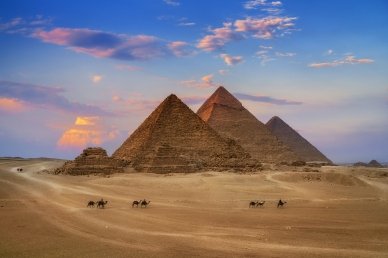
Pyramids of Giza
The reason is that engineering and humanitarian minds have struggled to unravel the mystery of pyramid construction since the first archaeological expeditions began. French archaeologist Auguste Mariette devoted 30 years of his life to studying the phenomenon of the Egyptian pyramids, having started his pursuits in the first half of the 19th century.
Later, German archaeologist Karl Lepsius joined his French counterpart. In 1880, the world's leading Egyptologists began extensive excavations, which have continued up to date.
At present, the complex comprises four parts — the Pyramids of Cheops, Khafre, Menkaure, and the Great Sphinx.
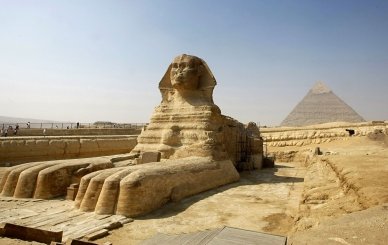
Great Sphinx
The Pyramid of Cheops is the only undamaged monument of antiquity among the seven wonders of the world. The other pyramids date back to the 23rd - 26th centuries BC and may well be regarded as the engineering marvel, considering the hoary antique period of their construction.
The complex is located 25 km from the Egyptian capital on the Giza Plateau. You may get here from New Cairo (also called Heliopolis) by buses number 355 and 357. This is the best option because the buses themselves are comfortable and equipped with air-conditioning. Some tourists prefer a taxi or the underground.
Abu Simbel
Even the avid travellers will be magnified with the two rock-cut temples on the Nile bank.
The first is the monument to Pharaoh Ramses II and the second — to one of his wives Nefertari Meritmut.
What makes the temples unique is not only their existence but also their particular aim. Twice a year, on December 22 and February 22, exactly at 6 a.m., a bright ray of sunshine pierces the eternal twilight of the ancient temples to throw light on the statues of the three divine beings. The main one is the statue of Pharaoh Ramses II lit for 12 minutes. The statues of Amun and Ra Horakhty are under the light for only 6 minutes. The deity of Ptah is the fourth one, but it is destined to be always in the shadows and never know the sunlight.
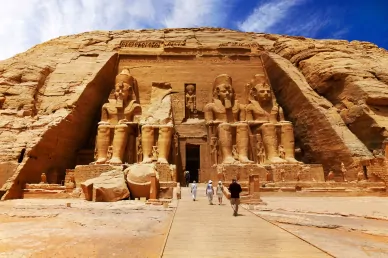
Abu Simbel
In the 1960s, Abu Simbel encountered a real journey: the temples were relocated to 180 m to prevent flooding by the Nile waters.
At that time, the Soviet engineers were constructing the second spillway of the Aswan High Dam. And thus, there was a real threat of destruction of the ancient rock-cut temple.
Thus, the temples were cut into 30-ton blocks and relocated to the second rock, which was in a safe place. Now Abu Simbel stuns the imagination with its might and incredible light effects.
It is possible to get to Nubia from Cairo and Sharm El Sheikh, but the way will take around 1,200 km and 900 km respectively. Some prefer going on a tour by car or bus, but an air flight will be the quickest and the most comfortable option.
Luxor
This city is a true treasury of Egypt and the entire Middle East: there is a whole complex of sightseeing attractions.
Luxor Temple is a sacrarium of Amun constructed in the times of Pharaoh Amenhotep. Only ruins now remind of the former glory, but they lure thousands of tourists from all over the world throughout the year.
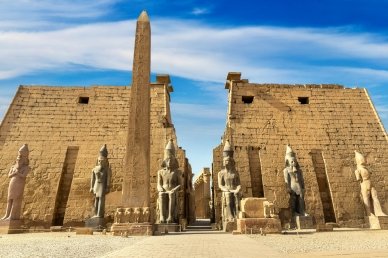
Luxor Temple
The Mosque of Abu Haggag was constructed to honour a great holy man, also called the father of pilgrims. The white mosque of unbelievable beauty welcomes thousands of Muslims annually during the two-day celebration of Abu al-Haggag, two weeks before Ramadan.
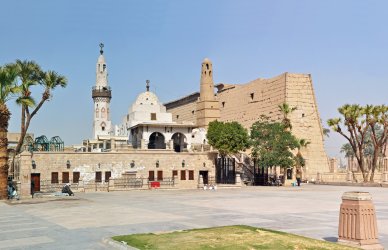
The Mosque of Abu Haggag
Karnak is the complex built 2.5 km from Luxor to celebrate the family of Egyptian deities — Amun-Ra, his consort Mut, and son Khonsu that constitute the Theban Triad.
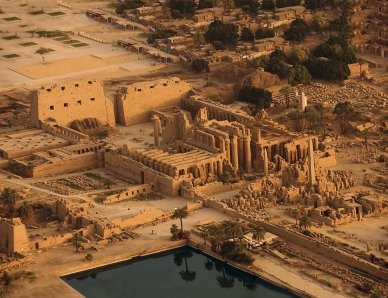
Karnak Temple
The City of the Dead is a necropolis on the outskirts of Luxor, quite an ominous place with a tragic history. In November 1997, 62 tourists died there as a result of the terrorist attack that occurred on the terrace of the Temple of Hatshepsut.
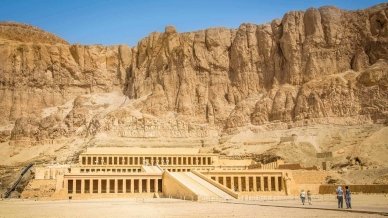
The City of the Dead, Luxor
The other attraction of the City of the Dead is Colossi of Memnon, the giant quartzite stone statues of the Pharaoh Amenhotep.
Once, they were destructed by an earthquake, after which one of the statues began making unusual noises. The winds blowing through the cracks created groaning and other human-like sounds. Interestingly, that phenomenon also served as a tuning fork to tune musical instruments.
Vocalizes stopped as abruptly as they began. In 199 AD, Emperor Septimius ordered to conduct repairs, and the cracks disappeared along with the strange vibrations.
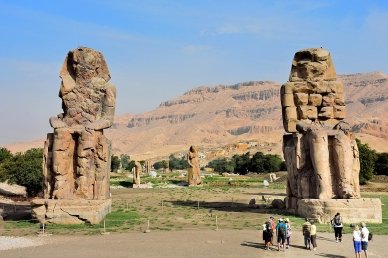
Colossi of Memnon
However, a lower part of the Colossi still impresses the visitors due to its ‘singing’ that occurs at the expense of special oddly-shaped holes and spaces inside. They make sounds at 5 a. m. in summer and after 7 p. m. in winter. And nobody knows the reason why this happens.
Sharm el-Sheikh
Tourists may get to this top Egyptian resort either by plane from their home country or by bus or plane from Cairo.
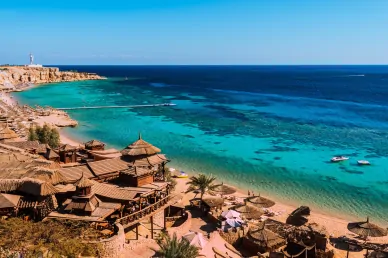
Sharm el-Sheikh
Those who get bored stiff with historical facts and events will savour this city for the conjunction of excellent beaches, warm sea, and parties. There is always much fun and noise; and the fans of diving, snorkelling, and other types of underwater entertainment will be overwhelmed with the variety of flora and fauna of the Red Sea.
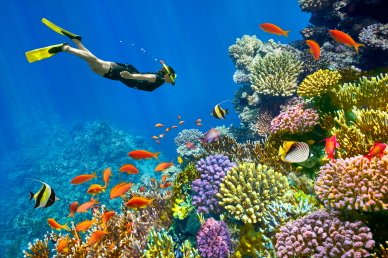
Diving in Sharm el-Sheikh
Nonetheless, Sharm el-Sheikh has its own attractions, and Mount Sinai is the most known. There Moses received the Ten Commandments from God and narrated them to Christians, who obey them even nowadays.
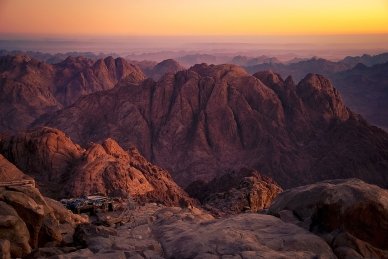
Mount Sinai
There are regular guided tours of Mount Sinai and St. Catherine’s Monastery, one of the oldest acting monasteries in the world.
Those who are not interested in the Biblical texts and religion enjoy walking around the Nabq and Ras Muhammad National Parks, delight with the beauties of the Tiran coral reef.
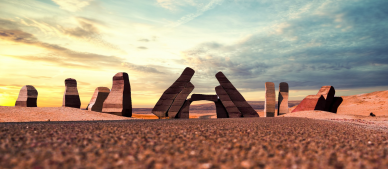
Ras Muhammad National Park
Shopping in Sharm el-Sheikh is a fascinating activity too. It resembles the oriental market a lot with huge supermarkets, shopping arcades, boutiques, and stalls that offer so many goods that one does not know where to look first. But tourists may also visit the oriental market itself; they just need to find time for visiting Old Town.
Hurghada
Everybody who plans a tour of the Red Sea area knows much about this city in the African part of the country.
Hurghada tourists have been perplexed in recent times due to the ongoing pandemic. However, there are still many of those willing to spend a vacation at the resort.
As well as Sharm el-Sheikh, Hurghada is a blessed place for fans of beach recreation. Only a few resorts are there in the whole world with such warm turquoise water and white sand.
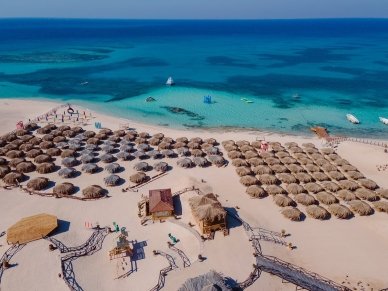
Hurghada, Egypt
Hurghada is not exclusively a beach resort. Though the number of places to see is small, you will remember them forever.
The majority is located in El Dahar — Hurghada Old Town. The must-see places are the Mosque El Mina Masjid, the Coptic Cathedral of Saint Shenouda, and, of course, the local market.
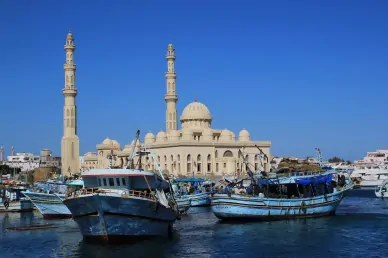
Mosque El Mina Masjid, Hurghada
If you are interested in the lives of pharaohs, attend the plays at 1001 Nights Palace. Theatrical performances are produced with the accompaniment of beautiful oriental music, bright costumes, and excellent rendition of professional actors — just the right things to plunge into the atmosphere of ancient Egypt.
The bravest will not get bored either. There is an amusement ride, a tour to the Arabian Desert, where tourists will have an opportunity for a quad bike ride on the desert quicksands, and a camel ride in friendly Bedouin villages.
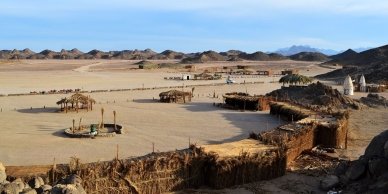
Bedouin village
Food
An all-inclusive vacation package will not make you able to understand what Egyptian cuisine really is. The hotels offer dishes commonly served in any European or American restaurant — various vegetable salads, typical meat and fish dishes, and ordinary desserts and sweet stuff.
You may taste the genuine cuisine of this Middle East country only at local cafes, family restaurants, and coffee shops. And there you should go to begin the gastronomical tour of Egypt.
Normally, the Egyptian menu resembles the one of the Arab world. It is unsurprising: the country has undergone its impact through the course of history.
So what food do the Egyptians consume? Everyday breakfast is usually very filling because a working day demands a lot of energy. That is why there are no sandwiches with tea or coffee but something fattening instead, like ful medames. It is a so-called beans stew cooked with olive oil, garlic, tomato sauce, spices, and herbs. A bowl of ful is quite enough to eat the fill and forget about the snacks.

Ful medames
Egyptian dinner is even more filling. It consists of a peculiar assortment of noodles, rice, pasta with fried onions, and lentils, which altogether constitute koshari — a popular garnish for meat or fish and the number one street fast food. So if you want to have a quick and very filling meal, just buy a bowl of koshari.

Egyptian koshari
Mahshi is a vegetarian recipe comprising vegetables stuffed with rice, spices, and herbs. Peppers, courgettes, aubergines have to be cleaned and filled with rice and vegetables to be then stewed.
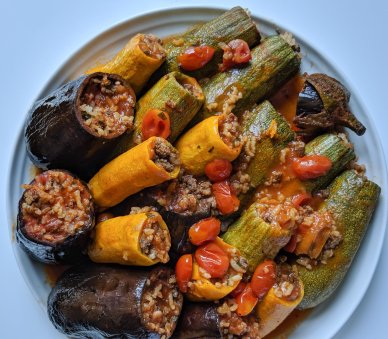
Egyptian Mahshi dish
Sayadieh fish is an Egyptian variation of pilaff, a holiday dish cooked for a big family gathering around the table. The ingredients include yellow rice, white fish, seafood, flavourous fried onions, and spices.
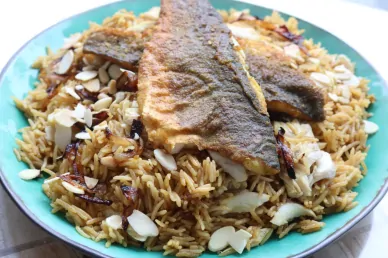
Sayadieh fish
If you have never tried watermelon in combination with cheese, gebna will be the exact thing to try. The dish comprises pieces of chilled watermelon flesh, soft cheese, some mint and basil, which are perfectly suitable to eat in the conditions of the local hot climate. You will hardly find a better dessert.
The principal drink of the Egyptians is fragrant and thick coffee. Depending on your preferences, Egyptian coffee shops can offer a cup of ziyada (sweet coffee), mazboot (medium-sweet), or sada (very bitter).

Egyptian coffee
Those dishes make only a small part of an extensive and truly authentic menu. Egyptian cuisine is worth trying; just do it.
Enigmatic and remote Egypt constantly entices with the mysteries of pyramids, quicksands, and ancient legends. It is old and young at the same time, warmly welcoming and generous as a person of Orient. If you decide to begin your acquaintance with this world in Egypt, the trip will be unforgettable.
FAQ
Is Egypt Arab or African?
Egypt is both Arab and African. It is located in Northeast Africa and is a member of the Arab League, with Arabic being its official language.
How large is Egypt geographically?
Egypt covers an area of about 1,010,408 square kilometers.
What is Egypt's population?
Egypt's population is over 100 million people.
What is the capital of Egypt?
The capital of Egypt is Cairo.
What are the 3 main languages in Egypt?
The official language is Arabic. English and French are also widely spoken, especially in tourist areas and among educated Egyptians.
What is the main religion in Egypt?
The main religion in Egypt is Islam, predominantly Sunni.
What is the Egyptian currency called?
The currency of Egypt is the Egyptian Pound (EGP).
What countries are neighbors to Egypt?
Egypt shares its borders with the following countries:
- Libya to the west,
- Sudan to the south,
- Israel and Palestine to the northeast.
Additionally, Egypt has coastlines along the Mediterranean Sea to the north and the Red Sea to the east, which places it in close proximity to countries across these bodies of water, such as Saudi Arabia and Jordan across the Red Sea, and Greece and Turkey across the Mediterranean.
Is Egypt's economy good?
Egypt has a mixed economy with agriculture, industry, tourism, and services sectors, but it faces challenges like high unemployment and inflation.
What is Egypt's biggest source of income?
Tourism, remittances from Egyptians living abroad, the Suez Canal revenues, and the petroleum industry are major sources of income.
What type of government is Egypt right now?
Egypt is a semi-presidential republic with a President as head of state and a Prime Minister as head of government.
What type of climate does Egypt have?
Egypt has an arid desert climate, characterized by hot, dry summers and mild winters.
What are the 5 largest cities in Egypt?
The five largest cities in Egypt are Cairo, Alexandria, Giza, Shubra El Kheima, and Port Said.
Which area is best to stay in Egypt?
In Cairo, areas like Zamalek and Downtown are popular. In coastal regions, Sharm El Sheikh and Hurghada are favored by tourists for their resorts and beaches. Luxor is great for historical sites.
What are the Egyptians most famous for?
Egypt is famous for its ancient civilization, the pyramids, the Sphinx, the Nile River, and its rich historical and cultural heritage.
Can you visit Egypt safely?
Yes, you can visit Egypt safely, but it's important to follow travel advisories, stay informed about local conditions, and take standard safety precautions, especially in tourist areas.
What is the best month to visit Egypt?
The best time to visit Egypt is from October to April, when the weather is cooler and more comfortable for sightseeing.
Do you need a visa to go to Egypt?
Visa requirements for Egypt vary by nationality. Many travelers need a visa, which can be obtained on arrival or online (e-Visa) for short visits.
Who can enter Egypt without a visa?
Citizens of a few countries, including Bahrain, Hong Kong, Kuwait, Lebanon (for arrivals at Sharm El Sheikh, Taba, Hurghada, Marsa Alam), Macao, Oman, Saudi Arabia, and the UAE can enter without a visa under certain conditions.







